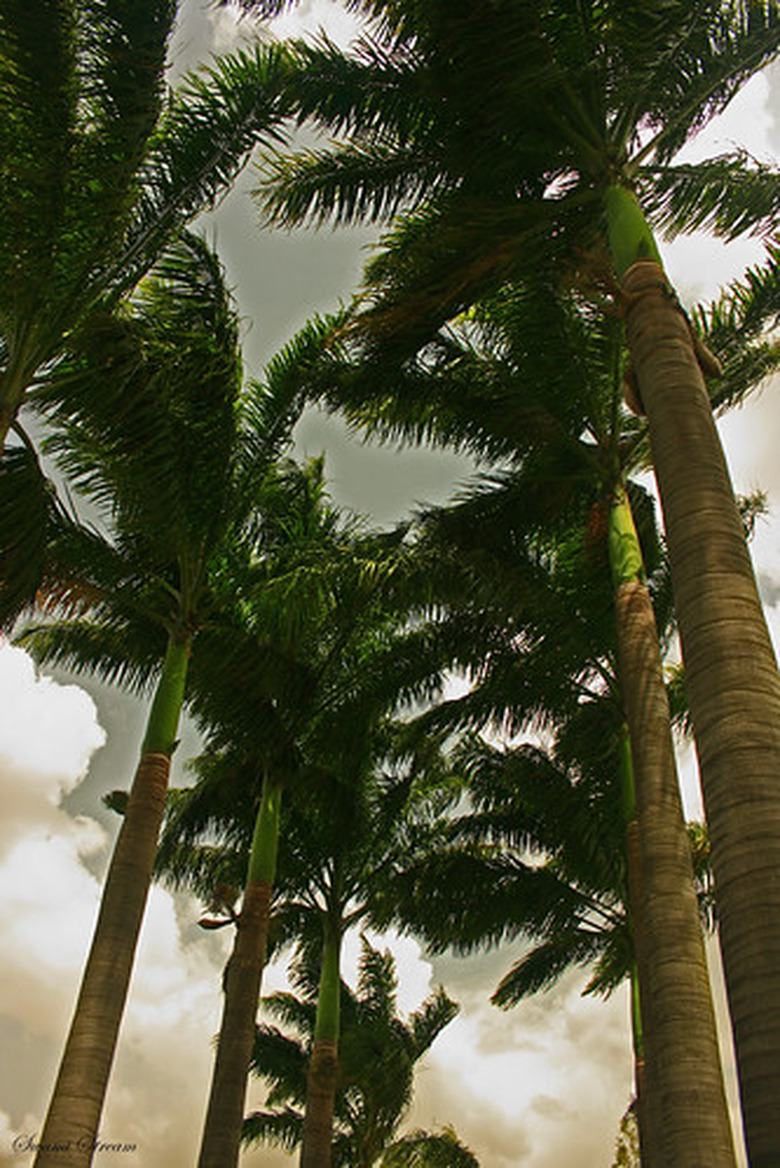Life Cycle Of A Palm Plant
Palms grow from seeds encased in dry or fleshy fruits in soil conditions that are warm and moist. The roots grow outward to anchor the upright stems or trunk that lack wood. As it matures, the fronds supply energy to form flowers that are pollinated by wind or insects, creating seeds. A palm is perennial, lasting for decades and producing annual crops of seeds.
Germination
All palms are monocots, or plants with seeds that emerge with only one leaf. Depending on palm species, germination of the seed falls into either of two forms. The first is remote germination, when a stem emerges from the seed in the soil and from this stem the root develops while the first leaf remains tucked inside the seed. The second possibility is adjacent germination, where the first leaf, the "button," only partially emerges from the seed and the root and further shoot growth extends from the button.
- Palms grow from seeds encased in dry or fleshy fruits in soil conditions that are warm and moist.
- As it matures, the fronds supply energy to form flowers that are pollinated by wind or insects, creating seeds.
Vertical Growth
Stems of palms extend upward and elongate at the crownshaft, the growing tip. Here the newest fronds are formed and unfold each growing season to form the crown, or cluster of fan-like or feather-like leaves. As the crownshaft grows, old leaves are shed away and leave scars on the palm stems or trunks.
Caliper Growth
Because palms are not trees and lack wood, they grow in caliper, or stem/trunk girth, by expanding the size of the tissues already present. As the palm matures, the caliper of each stem or trunk widens to a maturity determined by each specie's genetic code. If wounded, the stem/trunk does not heal itself like a true tree can by compartmentalizing the wound and sealing it from the elements.
Flowering
Palm flowers are tiny in comparison to other plants, but they are borne in large branching clusters called inflorescences. The inflorescence develops either from the crownshaft or anywhere on the plant's stem or trunk. Flowering occurs in the warmth of the growing season and in some palm species is grandiose and ornamental.
- Stems of palms extend upward and elongate at the crownshaft, the growing tip.
- Because palms are not trees and lack wood, they grow in caliper, or stem/trunk girth, by expanding the size of the tissues already present.
Some palm species flower only once and are called monocarpic. After the palm blooms and sets fruits, it will slowly die, being either replaced by a new young plant or by new basal stems or trunks from the roots.
Fruiting/Seeds
Flowers are pollinated by wind, insects, bats or birds, depending on palm species and geographic location. The fruits are borne in clusters like the flowers. There is variation in size, texture and covering of palm fruits by species, and usually only one seed occurs in each fruit. Exceptions exist, to up to as many as 10 seeds per fruit.
The fruits are either eaten by animals and the seeds scattered in droppings or the fruits merely drop from the palm and then germinate when conditions are right.
- Some palm species flower only once and are called monocarpic.
- After the palm blooms and sets fruits, it will slowly die, being either replaced by a new young plant or by new basal stems or trunks from the roots.
Death
Environmental stresses along with old age lead to a palm's demise. Drought, flooding, insect pests or diseases can harm plants and in some species the palm naturally dies once it flowers and sets seeds. If the crownshaft is damaged, the fronds are reduced in numbers or no longer created. Once leaves diminish, the palm cannot sustain itself and the plant slowly dies, first seen with yellowing leaves and ending with rotting of the stems or trunk.
References
- "An Encyclopedia of Cultivated Palms"; Robert Lee Riffle and Paul Craft; 2003
- University of Florida IFAS: Palm Seed Germination
